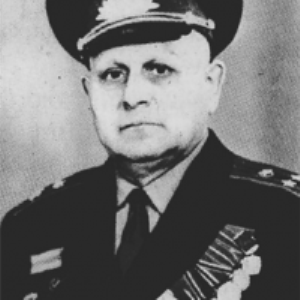Khaskil, or Khaskel, Pinkhasov was born in 1911 in the village of Djiganas, near the town of Ust-Dzheguta (now in the Karachay-Cherkess Republic) in the Northern Caucasus, Russia, into a family of Mountain Jews. In the 1930s he graduated from two military schools and became a political commissar, first on the company level. In 1939 and 1940, Pinkhasov took part in the Soviet-Finnish (Winter) War, and in summer of 1940 – in the Soviet annexation of the Romanian province of Bessarabia. Then he continued his military service in the same area.
The Soviet-German war began for Lieutenant Pinkhasov in Bessarabia. Romania, which was an ally of Germany, attacked Pinkhasov's unit and he was wounded. In 1942 Pinkhasov fought in the Northern Caucasus and was wounded for the second time in October of that year. Pinkhasov's nearly legendary status among the Mountain Jews of this region began in January 1943, after the battle for Nalchik.
Before the war Nalchik, the capital of the Kabardino-Balkar Republic (in the Northern Caucasus) was home to one of the largest communities of Mountain Jews (In 1939, they numbered about 3,000 or 10% of all Mountain Jews living in the Soviet Union at this time). Nalchik was captured by German forces on October 28, 1942. During the 65-day long German occupation of the town, the Germans shot several dozen Ashkenazi Jews (mainly refugees from Poland and the western part of the Soviet Union) plus approximately ten Mountain Jews who were Communists. However, the occupiers did not murder all the Mountain Jews since Nazi ideologists could not decide whether the Mountain Jews were actually racially Jewish or not, finding it difficult to distinguish them from the surrounding Muslim population. Eventually, the Nazis decided that they were Jews and scheduled the mass murder of Nalchik's Mountain Jews for January 4, 1943 (during a critical period of the battle of Stalingrad, which was 600-700 km north of Nalchik).
At that time the 265th Mountain Rifle Regiment, in which Colonel Pinkhasov served as deputy commander for political matters, was deployed close to Nalchik. He learned from Soviet reconnaissance about the Germans plan to shot all of Nalchik's Jews. Pinkhasov was already aware of the German murder of Mountain Jews in Bogdanovka (among the 472 victims killed there were members of his family) and in nearby Ganshtakovka (which later was renamed Menzhinskoie but which no longer exists), as well as in some other places. Acting on his own authority, Colonel Pinkhasov, along with some of his men, entered Nalchik several hours before the murder operation was going to start. The first question posed to local residents by this Mountain Jew on horseback was "Are our people still alive?" He cried from joy when he learned that he had arrived in time to save his people.[1] From then on, the Jews of Nalchik have celebrated the day of their rescue as a holiday.
Pinkhasov continued to fight in the Northern Caucasus in 1943. He ended the war in Germany. In the course of the war, he was awarded three orders.
After the war, Pinkhasov continued his military service. He retired in 1953, after which he served in a civilian capacity at the Nalchik recruitment office. He played a major role in the erection (in 1965) of a monument to the Jewish victims in Bogdanovka.
Khaskel Pinkhasov died in 1988. He was buried at the Jewish cemetery in Nalchik. Hundreds of people attended his funeral. His daughter and grandchildren now live in Israel.
[1] Danilova, Svetlana. Gorskie evrei v Kabardino-Balkarii. Nalchik: Elbrus, 1997, p. 60.







